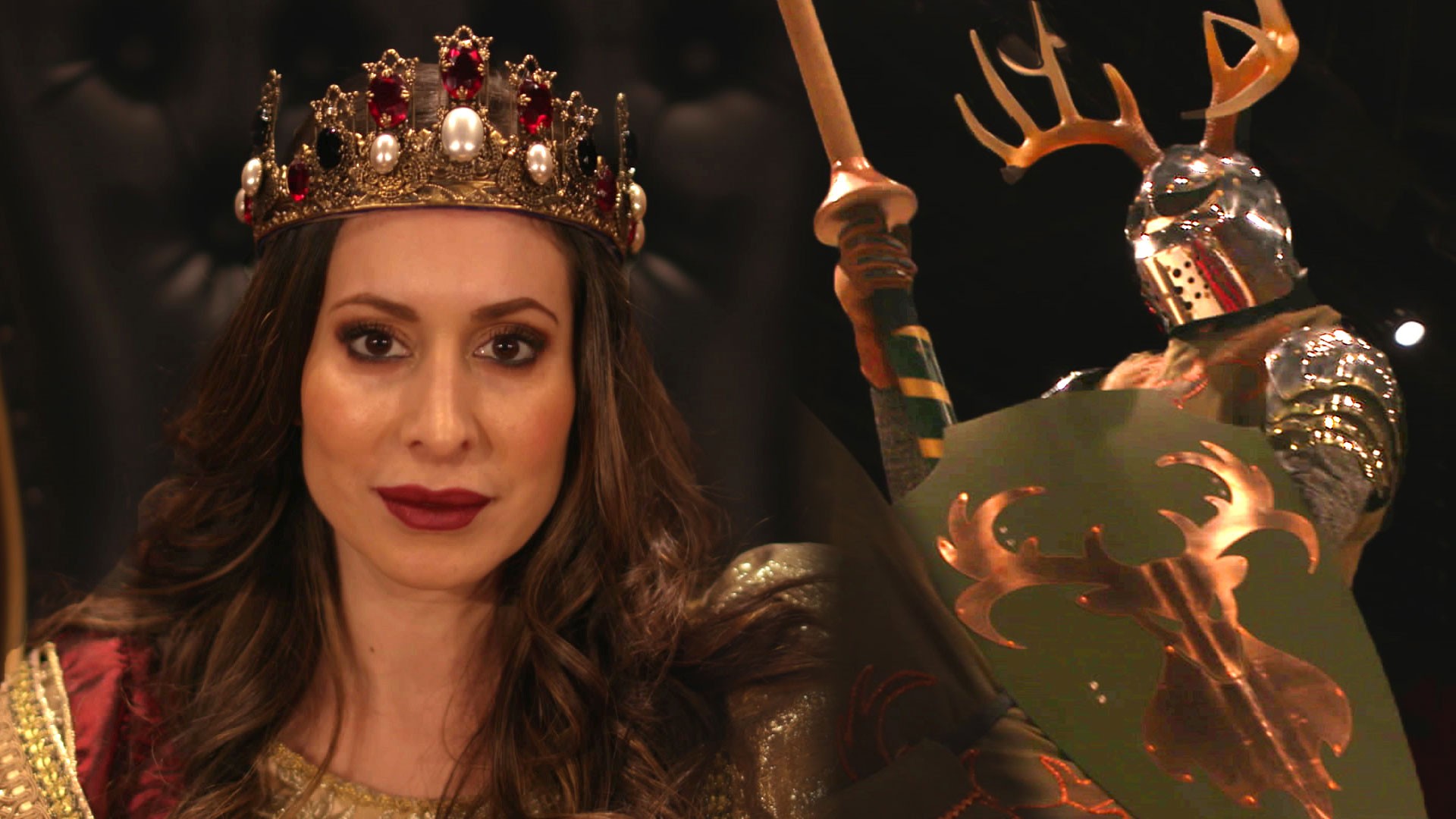I am an ardent fan of Medieval Times, the chain jousting tournament–slash–dining experience. I love that you are meant to eat an entire half of a chicken as well as a potato with no utensils while there; I love watching the knights, who are sexy, fight each other with a stunning variety of weapons; I love that the employees refer to you exclusively as “m’lady,” even when you are drunkenly demanding the WiFi information (“You must log in through your Facebook account, m’lady”).
Advertisement
The only part of the experience I did not particularly enjoy was the lack of women. For 34 years, the joust, which pits six (all-male) knights against each other, was overseen by an aging king and a mostly decorative princess. The first time I attended a Medieval Times feast, having partaken of too much mead, I had an earnest and impassioned conversation with a serving wench about this subject. She agreed with my complaint—there should be female knights!—and ventured that the whole “wench” thing was weird as well. (I have since been assured that this is historically accurate, and “wench” had no negative connotation back in the day, to which I say, simply: OK.)I was understandably thrilled to learn, earlier this month, that Medieval Times locations throughout the country are rolling out a new show—one in which the king figure is replaced by a benevolent yet authoritative queen, Doña Maria Isabella, who rules entirely on her own. I first read about this development in the Chicago Tribune, which called it “a girl-power moment,” and stressed that the “updated narrative had aptly landed… in a cultural moment of women’s marches, #metoo reckonings and female superheroes.” I should confess here that I didn’t realize there even was a king who oversaw the joust until my second journey to Medieval Times, and even then I was only vaguely aware of him. (The copious mead-drinking is part of the authentic medieval tradition that I cherish and honor with religious fervor; I fared better than some of my friends, who failed to notice, over the course of the two-hour show, that there were knights riding around.) On my third trip to Medieval Times, on the occasion of my 25th birthday, I called ahead. The woman who answered the phone was overjoyed to hear that my twin sister and I would be spending our special day there. “What should we call you when we read your names?” she wondered warmly, referring to a practice in which the king publicly enumerates all the birthday princes and princesses in attendance.
I should confess here that I didn’t realize there even was a king who oversaw the joust until my second journey to Medieval Times, and even then I was only vaguely aware of him. (The copious mead-drinking is part of the authentic medieval tradition that I cherish and honor with religious fervor; I fared better than some of my friends, who failed to notice, over the course of the two-hour show, that there were knights riding around.) On my third trip to Medieval Times, on the occasion of my 25th birthday, I called ahead. The woman who answered the phone was overjoyed to hear that my twin sister and I would be spending our special day there. “What should we call you when we read your names?” she wondered warmly, referring to a practice in which the king publicly enumerates all the birthday princes and princesses in attendance.

Advertisement
“We would like to be called kings,” I told her cheerfully. Faced with baffled silence, I continued, losing steam, “Women kings… We would like to be referred to as kings…” A few days later, at the grand event, the king and I finally acknowledged each other’s existences—“Happy birthday to twin princesses, Callie and Blair!” he intoned over the loudspeaker—though he was apparently reluctant to cede us his title.This is a long way of saying that having a female ruler at Medieval Times is a milestone that I have spent years awaiting and personally agitating for. And thus, on a dreary day in mid-January, I journeyed to the New Jersey castle to witness some admittedly ahistorical history in the making.I arrived at Medieval Times in Lyndhurst, New Jersey, in the afternoon, several hours before the doors would open to the public. It was the queen’s opening weekend at this location (the Dallas and Chicago castles were the first two to roll out the new show), and the cavernous entrance hall in which guests would later convene seemed to buzz with anticipation. A row of brightly colored frozen drink mixes sloshed about in their plastic receptacles, churning in aimless perpetuity. Empty beer goblets glinted feebly in the half-light. In the corner, one decorative throne was stacked atop another. Several suits of armor stood by patiently.Into this slightly surreal vista strode a procession of three queens, all in the same regal ensemble: an ornate, gold bodice from which crimson fabric flowed, topped with a voluminous golden cape, and, most notably, a sturdy, jewel-encrusted crown—a considerable upgrade from the tiara of yesteryear.
Advertisement
One of these queens, Jess, would be making her debut later on, and the other two were there to do press with some local news stations. “This role is completely different,” Jess told me emphatically, when asked how it diverged from the princess part. “Queen Isabella is in charge of everything.”
The queens before the show; Jess is in the center
In one previous version of the show, the princess was married to the king’s son; in another, she was his unwed daughter. Her involvement in the plot was usually contingent upon some dispute about marriage or her husband. In the new iteration, however, Queen Isabella is both single and pointedly not looking to settle down—“Whatever has that to do with the tournament?” she demands indignantly when a bumbling male advisor notes (accurately!) that some of the assembled knights are both handsome and eligible.Leigh Cordner, a former Medieval Times king and the current creative director of the show, says he was careful not to make the queen too defensive; in the first version of the script, she was constantly defending herself and her right to rule. When Cordner showed it to some of the women in the corporate office, they told him his approach was wrong. “What they said is, ‘If that was a king, why would he constantly have to be justifying why he was king?’” he recounted, his sonorous voice echoing throughout the castle in a truly regal fashion. “Because, you know, she’s born into it."Towards the end of the new show, though, a particularly churlish knight questions Queen Isabella’s authority, and receives a formidable—and very deserved—verbal lashing. “There’s actual conflict with one of the knights who resents being told what to do by a woman and feels like she’s an intruder into their dominion,” Cordner said. “That’s where she gets really strong. I can tell from the reaction in the audience—especially female voices—that when she finishes that speech, they’re like, ‘That’s right, girl! You tell him!’”
Advertisement
I found the intent behind these feminist flourishes touching. Before the show began, I slipped into the castle’s Museum of Torture, a series of narrow rooms in which medieval torture devices are displayed, and found yet another such flourish: Beside a grotesque iron mask called the “scold’s bridle,” an informational card explained, “These devices… were used to silence women who were critical of society, the state, or, most often, the arrogance of the male power structure.”
Some knights engaged in dramatic tussling
And here we were, in a brave new world where we all could agree that the only person deserving of a scold’s bridle is the foolish knight who dared challenge the queen! The arrogance of the male power structure was crumbling like an untrained squire felled by a mighty lance! I would like to say that the tournament that followed was a riveting display of girl power in a cultural moment of female superheroes, but, to be honest, it was surprisingly easy to disengage with the plot, which was contained to a small platform overlooking the arena and progressed in bursts between several elaborate processions on horseback, the releasing of a falcon, and a lot of dramatic tussling among the knights.Still, the queen’s coronation remains symbolically relevant—and quite timely. Shortly after I left the castle, one of my friends messaged me a post from an Instagram account called Overheard in LA. This particular phrase had been Overheard at the Medieval Times castle in Buena Park, California. “Where are the female jousters?” it read. “Medieval Time’s Up.”Cordner, who has been asked about #TimesUp in basically every write-up of the new show, insists the timing is coincidental. “I started working on this show about 18 months ago,” he clarified, somewhat defensively, then grew more thoughtful. “It’s hard to know how you feel about it because… there’s a lot of grief involved in the movement itself. My take is if we can help the conversation—and what we have been noticing is little girls after the show: ‘Oh, I love the queen, and I could be the queen,’ or just seeing a strong woman in a strong role—if we can help the conversation doing that, that’s great, but you know, our show’s not about politics.”It makes sense that the show, a novelty dinner experience based on violent feudalism, is not about politics. But—and I say this as someone who once ruined a Renaissance Faire pub crawl by loudly decrying the town bard’s casual misogyny—it is always reassuring to see people challenging assumptions about male authority, even if most audience members are too busy eating chicken with their hands to fully comprehend what’s going on. Perhaps one day the queen will liberate the serfs and serving wenches and institute full matriarchy—or, at the very least, maybe we’ll get a female knight.
